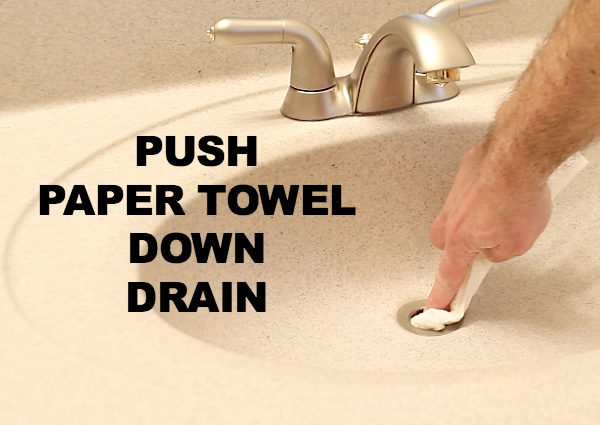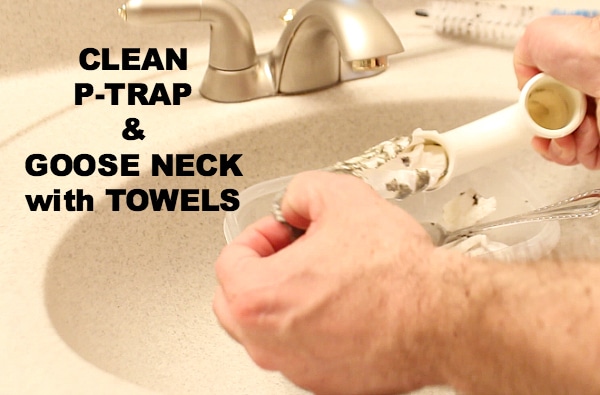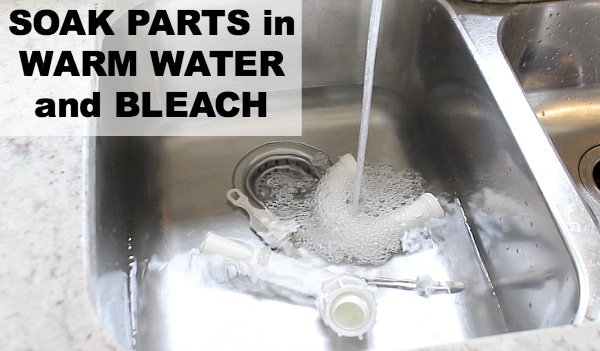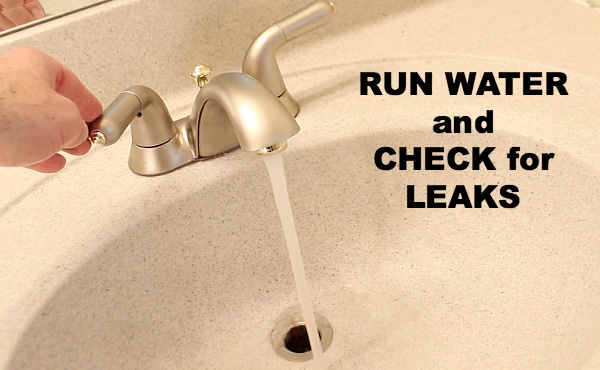No matter how much you clean your bathroom sometimes the sink drain just flat out STINKS!!!
A few weeks back our friend asked me how to get rid of the sewer smell coming from a bathroom sink.
I have a pretty darn good method for this problem and figured I’d share it with you.
Hey, I’m not ashamed to say that our drains get downright disgusting.
Shaving cream, toothpaste, soap and skin cells collect in drains. This turns into a biofilm stew that would make raccoons squeamish.
I’m stoked to show you my amazingly easy and effective way to eliminate stinky drain odors. Let’s get started 🙂
Supply List for Cleaning Stinky Sink Drains
Here’s your supply list
- Paper Towels
- Appliance Brush
- Plastic Container
- Crescent Wrench
- Channel Locks
- Narrow Spoon
- Oven Mits
- Boiling Pot of Water
- Toothbrush (NOT YOUR SPOUSE’S)
- Bleach
- These Amazon affiliate links help support HRT…gracias
In about 1 hour you’ll have a fresher smelling bathroom. Cool stuff.
What’s the Difference Between Booby Traps and P-Traps: Water!!
If you’ve seen Goonies the movie you know booby traps are obstacles that cause headaches for the good guys.
Your p-trap can be a super bad booby trap if there’s no water in it.
Water at the bottom of p-traps prevents sewer gas from entering your home.
Your bathroom will stink worse than the elephant cage at the zoo if the p-trap dries out.
FYI, your toilet also has a p-trap in the bowl. This smell is worse than the one from your sink because your toilet is sitting directly over the main sewer stack.
No matter what, always make sure there’s water in all your p-traps to prevent sewer gas from permeating your bathroom.
If for some reason you don’t have a p-trap make sure you add one under your sink.
A second reason you might have a foul smell coming from your bathroom sink is the growth of biofilm in the pipes.
Don’t be alarmed, we all have this issue.
Shaving cream, toothpaste, soap, old skin cells all contribute to biofilm. Yes, it’s disgusting but totally not a a big deal.
You’ll need to remove the sink’s p-trap, goose neck, pivot rod, and pop-up drain stopper.
Start with the p-trap by placing your container under it and unscrewing the two nuts that hold it to the drain and goose neck.
Chances are good that you’ll see a gray or black residue on the p-trap. This is biofilm.
Next, loosen the nut that holds the pivot rod to the sink drain. Remove the pivot rod from the drain and set it aside.
Now you can pull the pop-up stopper from the drain.
I’ll warn you, it will be filthy and if you have a strong gag reflex maybe have a spouse or friend do this.
The last part is to unscrew the goose neck that connects to the wall drain. Turn the nut counterclockwise with your hand or a set of channel locks (in case the last installer was the Incredible Hulk).
See all that black stuff in the above picture? It’s biofilm. Just nasty!!!!!
Oh, I almost forgot.
A great tip at this point is to take a long skinny spoon and scrape any sediment from the wall drain into your container. Yes, this is vulgar, too. But helps with the cleaning process.
Okay, let’s clean the stinky pipes and sink parts that we just removed.
Attention Mr. Clean: Take Some Notes Because You’re About to Get Schooled
Nothing against Mr. Clean, he’s a good guy.
But there’s more to just tossing chemicals down the drain.
You need to get all the biofilm off your pipes. After all, that’s what’s causing the stinky smell.
Take a paper towel and roll it up like you would do to a magazine when trying to kill a fly (if you’re a PETA member, I only kill flies when necessary).
Push the paper towel down the sink drain.
Then use an appliance brush to push the paper towel through the end of the sink drain. This is way cool because the abrasive action of the towel and the brush thoroughly clean the sides of the sink drain.
Do this 2 to 3 times and you’ll be amazed at all the gunk that comes out of the drain.
Place your container under the drain to catch the towels and biofilm.
Use the same paper towel method on the p-trap and goose neck.
Then take them into the kitchen along with the pivot rod & pop-up stopper.
Fill up your kitchen sink with enough warm water to cover the sink parts then add about 1/4 cup of bleach.
This is the only use of chemicals aside from one other tip I mention in the video.
Let the sink parts soak for 10 minutes then remove them from the water.
The Last Step: Boiling Water is Biofilm’s Worst Nightmare
Before you start to take your bathroom sink drain apart, place a pot of water on the stove.
Allow it to heat up enough so that it boils.
This takes about 10-15 minutes which is enough time for you to put all the sink parts back together.
Start by placing the goose neck into the wall drain. Tighten the slip nut so that the goose neck is locked in place.
The nice part is that if you don’t move the plastic washer on the goose neck you won’t need to guess how far to push the goose neck into the wall.
Place the short end of the p-trap up against the goose neck and the longer end up onto the sink drain.
This is super important: make the end of the goose neck sit flush with the p-trap then tighten the slip nut by hand.
If you don’t make these fittings flush and snug YOU WILL HAVE A LEAK.
This isn’t a big deal but a pain in the butt.
Do the same thing with the end of the p-trap that slips onto the drain only this time ensure the slip nut washer sits flush with the top of the p-trap.
Again, tighten the slip nut by hand and use channel locks to ratchet down by 1/4 turn.
Put the pivot rod back into the drain and tighten it’s nut. Reattach the pivot rod to the clevis (strap with holes in it) using the metal clip.
Run the water in the sink and check for any leaks.
If you’re vanity base is bone dry you’re ready for the boiling water.
Pour it down the sink in 2 cup increments.
The boiling water will do two things: further disinfect the sink drain and move any remaining grime down into the main sewer stack.
You might be asking “BUT won’t the boiling water ruin my plastic pipes??????”
If you’ve got ABS or PVC pipes you need not worry. All the fittings glued together are very strong and can withstand hot water.
I’ve done this several times and plumbers actually recommend this technique.
But, if you’re really worried about the boiling water causing problems then I have a second option for you. I mention it in the video and it has to do with Wet N Forget Indoor.
Click on the video below to see all the juicy details.
The last step is to put your sink’s pop-up stopper back into place.
WOO-HOO!!!!!
Your sink no longer smells like the swamp thing.
However, your bathroom might have a wonky scent for a few hours from the cleaning process.
So be prepared to get a little grief from family members or roommates but the pungent odor will disappear.
What’s Next
Our tutorial showing how to unclog a kitchen sink also comes in handy – and saves that expensive call to the plumber.
If you’re doing a bathroom remodel and need help, join one of our online courses – they’ll make your bathroom renovation much easier!
Let me know if you have any questions and I’ll do my best to help.
Thanks as always for reading, watching, and being part of our awesome community.
Cheers,
Jeff


















